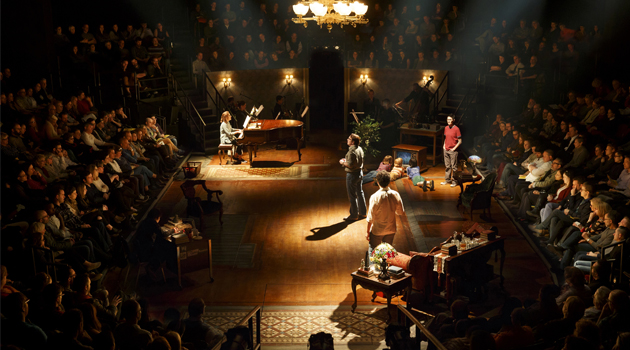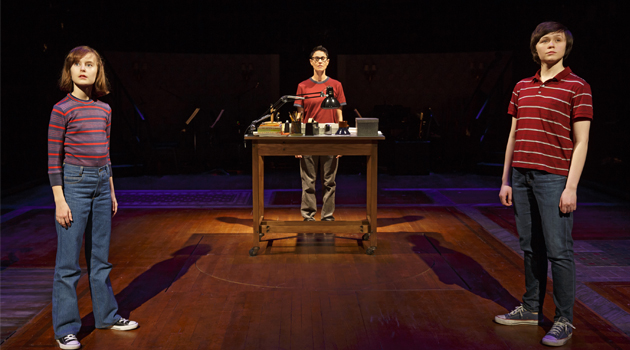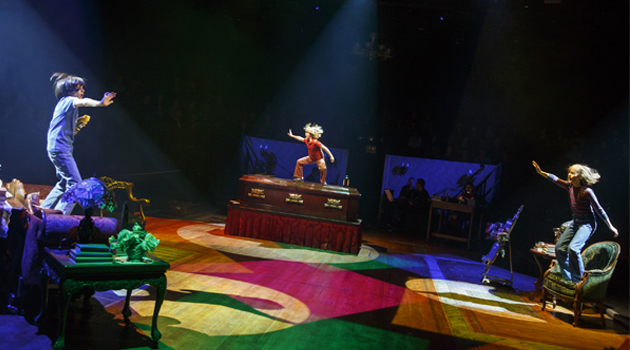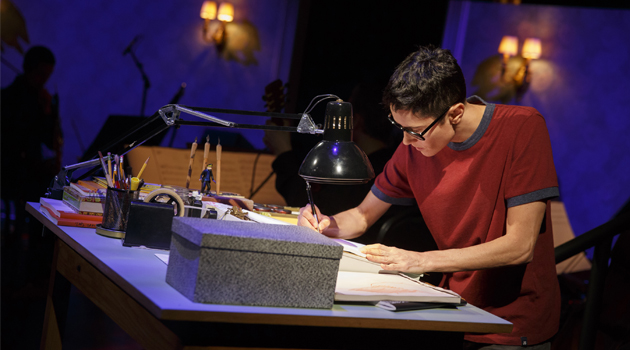ETC products are at home on Tony Award-nominated Fun Home
Date Posted: 6/5/2015

With strong reviews, word-of-mouth recommendations, and 12 Tony Award® nominations, the musical
Fun Home
appears to be right at home in its Broadway house, having moved uptown after a successful run at The Public in 2013. By Broadway-musical standards,
Fun Home
- which is based on an autobiographical graphic novel by Alison Bechdel - is an unusual show. "The musical itself is incredibly delicate. It's not a big, flashy musical," says lighting designer Ben Stanton, who - along with director Sam Gold, much of cast and creative team - earned a Tony Award nomination for the show. In
Fun Home,
an adult Alison grapples with memories of her late father, whose complicated legacy is deeply entwined with her own coming-of-age story. One part family drama and one part memory play, with the occasional, pared-down musical number,
Fun Home
is, as Stanton calls it, "a low-tech, organic show." In moving to Broadway, the creative team also faced an unusual challenge: while the production at The Public was performed in a proscenium setting, its new home, the Circle in the Square, is an intimate theater in the round. Suddenly, Stanton found himself with a low-tech show in need of high-tech lighting.

As a designer, Stanton describes himself as being obsessed with storytelling. In
Fun Home,
Alison's narrative unfolds in flashbacks, flitting from early childhood to young adulthood to middle-age and back. Stanton's shifting pockets of light follow the action from scene to scene, defining rooms of different shapes and sizes as furniture appears and disappears through a complex series of traps.
The lighting team needed a workflow that would allow them to quickly move these 'bubbles of light' around the stage. Using an ETC
Eos Ti®
lighting desk, programmer Alex Fogel built a low-res, 5in x 7in pixel map encompassing the whole stage, with each lighting area as a separate pixel. By applying a gradient to the intensity parameter of the area lights, he was able to smoothly drag focus around the playing area, responding quickly to changes in blocking, while maintaining the intimate look of the scene. To ensure that the show looked good from all angles, the lighting team spread out over three tech tables. Even so, Stanton explains, accounting for all vantage points means that "you have to design it five different times."

Because the show had been staged before with the same creative team, he says: "We spent a lot of time making sure that things that worked downtown still landed in the round." Sometimes the new venue prompted significant changes. At The Public, back-wall projections were used to reinforce key moments in the show and to liven up the occasional dance number with bursts of color. Transferring to a venue with no walls to speak of, many of these visual and narrative duties now fell to the lighting team. "The show is all about the deck," adds Stanton. "The floor is the backdrop." At times, characters are placed inside frames projected on the floor from custom gobos, referencing the hand-drawn panels of a graphic novel. One jubilant dance sequence involves disco squares, while at another, bleaker moment, the lighting pulls back from the edges of the open trap doors, and chunks of the stage picture seem to go missing.
In order to accommodate these varied scenes and the demands of lighting in the round, Stanton knew that he needed color-changing fixtures. Here, the intimacy of the theater posed another challenge. The subterranean theater at Circle in the Square has a steep audience rake, a low ceiling, and the catwalks of the lighting grid are only a short ladder's climb above the outer ring of seats. "In this space in particular, we were petrified of noise," describes Stanton. "I needed the quietest rig in New York." He initially specified color scrollers for the rig, planning to limit his gel selection and hope for the best. He even took chances with the fans turned off. But noise was still going to be a problem.

All that changed when rental house Christie Lites offered to substitute
Source Four® LED Series 2 Lustr®
luminaires for the 200-plus scroller fixtures in the
Fun Home
rental package. None of the lighting team had used the Series 2 luminaires before, but they were quickly won over by the high light output, minimal power needs, and of course the lack of fan noise. "I'm not a gearhead. I'm not the kind of person who would put technology on a show for the sake of putting technology on a show," says Stanton, who had initial reservations about introducing new technology to an already complicated tech process. The learning curve was minimal, however. "I had to relearn how to design a bit for lights that don't warm when they dim," he says. "But Alex went through color by color with Lustrs and gels [on Eos Ti] and was able to match perfectly any color I'd have wanted." Stanton was particularly impressed with the LED luminaires' ability to mix deeper colors: "Some of the blues are insane." The ability to cue area lights using color, as well as intensity, turned out to be a big asset to the production. Given more time, he and Fogel would have liked to play with pixel-mapping for color control, to make color manipulation that much more seamless. The Source Four LED Series 2 Lustr luminaires "take us from a simple, subtle look to the most vibrant color you'll ever see," he describes. And that helps differentiate the worlds of memory and storytelling within the show.
The 'high-tech' rig required by the show's new home has given the musical a new kind of streamlined simplicity. Though it came hand-in-hand with technological complexities,
Fun Home
's move proved to be a boon to the production. "In the round, the audience is no longer separated from the story by a line. They are in the story, in the house," Stanton concludes, referring to the elaborate, Victorian home of Bechdel's childhood memories. "We think the change is really strong."
All photos © Joan Marcus, courtesy of O&M Co.